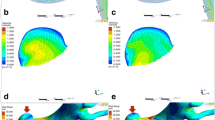Abstract
An endovascular technique using a stent has been developed and successfully applied in the treatment of wide neck aneurysms. A stent can facilitate thrombosis in the aneurysm pouch while maintaining biocompatible passage of the parent artery. Insertion of the stent changes the flow characteristics inside the aneurysm pouch, which can affect the intra-aneurysmal embolization process. The purpose of this study is to clarify the velocity and wall shear stress changes that are caused by stenting in fusiform and lateral aneurysm models. We used a flow visualization technique that incorporated a photochromic dye in order to observe the flow fields and measure the wall shear rates. The intra-aneurysmal flow motion was significantly reduced in the stented aneurysm models. Coherent inflow along the distal wall of the aneurysm was diminished and inflow was distributed along the pores of the stent wall in the stented models. Also, sluggish intra-aneurysmal vortex motion was well maintained in the stented aneurysm models during the deceleration phase. A less porous stent generally reduced the intraneurysmal fluid motion further, but the porosity effect was not significant. The magnitude and pulsatility of the wall shear rate were reduced by stenting, and the reductions were more significant in the lateral aneurysm models compared to the fusiform aneurysm models. The hemodynamic changes that were observed in our study can help explain the efficacy of in vivo thrombus formation caused by stenting. © 2002 Biomedical Engineering Society.
PAC2002: 8719Uv, 8780-y, 8719Xx
Similar content being viewed by others
REFERENCES
Aenis, M., A. P. Stancampiano, A. K. Wakhloo, and B. B. Lieber. Modeling of flow in a straight stented and nonstented sidewall aneurysm model. ASME J. Biomech. Eng. 119:206-212, 1997.
Diamond, S. L., J. B. Sharefkin, C. Dieffenbach, K. Frazier-Scott, L. V. McIntire, and S. G. Eskin. Tissue plasminogen activator messenger RNA levels increase in cultured human endothelial cells exposed to laminar shear stress. J. Cell Physiol. 143:364-371, 1990.
Francischelli, B. E., J. M. Tarbell, and D. B. Geselowitz. Local blood resident times in the Penn State Artificial Heart. Artif. Organs 15:218-224, 1991.
Frangos, J. A., L. V. MaIntire, S. G. Eskin, and C. L. Ives. Flow effects on prostacyclin production by cultured human endothelial cells. Science 227:1477-1479, 1985.
Gobin, Y. P., J. L. Counord, P. Flaud, and J. Duffaux. In vitro study of hemodynamics in a giant saccular aneurysm model: Influence of flow dynamics in the parent vessel and effects of coil embolization. Neuroradiology 36:530-536, 1994.
Grabowski, E. F., E. A. Jaffe, and B. B. Weksler. Prostacyclin production by cultured human endothelial cells exposed to step increases in shear stress. J. Lab. Clin. Med. 105:36-43, 1985.
Graves, V. B., C. M. Strother, C. R. Partington, and A. Rappe. Flow dynamics of lateral carotid artery aneurysms and their effects on coils and balloons: An experimental study in dogs. AJNR Am. J. Neuroradiol. 13:189-196, 1992.
Hayashi, K., H. Handa, S. Nagasawa, A. Okumura, and K. Moritake. Stiffness and elastic behavior human intracranial and extracranial arteries. J. Biomech. 13:175-184, 1980.
Knuckey, N., R. Haas, R. Jenkins, and M. Epstein. Thrombosis of difficult intracranial aneurysms by the endovacular placement of platinum-dacron microcoils. J. Neurosurg. 77:43-50, 1992.
Lieber, B. B., A. P. Stancampiano, and A. K. Wakhloo. Alternation of hemodynamics in aneurysm models by tenting: Influence of stent porosity. Ann. Biomed. Eng. 25:460-469, 1997.
Marks, M. P., M. D. Dake, G. K. Steinberg, A. M. Norbash, and B. Lane. Stent placement for arterial and venous cerebrovascular disease: Preliminary experience. Radiology 191:441-446, 1994.
Mayberg, M. R., H. H. Batjer, and R. Darcey. Guidelines for the management of aneurismal subarachnoid hemorrhage. Circulation 90:2592-2605, 1994.
Nichols, W. W., and M. F. O'Rourke. McDonald's Blood Flow in Arteries. London: Lea and Febiger, 1990.
Ojha, M., R. L. Hummel, R. S. C. Cobbold, and K. W. Johnston. Development and evaluation of a high resolution photochromic dye method for pulsatile flow studies. J. Phys. E 21:998-1004, 1988.
Palmaz, J. C. Intravascular stents: Tissue stent interactions and design considerations. AJR, Am. J. Roentgenol. 160:613-618, 1993.
Pektold, K., M. Resch, and H. Florian. Pulsatile non-Newtonian flow characteristics in a three-dimensional human carotid artery bifurcation model. ASME J. Biomech. Eng. 113:464-475, 1991.
Rhee, K., and S. M. Lee. Effects of wall motion and flow wave form on the wall shear rate distribution in the divergent vascular graft. Ann. Biomed. Eng. 26:955-964, 1998.
Rhee, K., and J. M. Tarbell. A study on the wall shear rate distribution near the end-to-end anastomosis of a rigid graft and compliant artery. J. Biomech. 27:329-338, 1994.
Scott, S., G. G. Ferguson, and M. R. Roach. Comparison of the elastic properties of human intracanial arteries and aneurysm. Can. J. Physiol. Pharmacol. 50:328-332, 1972.
Tominaga, R. H., C. Harasaki, H. Sutton, H. Emoto, H. Kambic, and J. Hollman. Effects of stent design and serum cholesterol level on the restenosis rate in atherosclerotic rabbits. Am. Heart J. 128:1049-1058, 1993.
Wakhloo, A. J., O. Fermin, B. B. Lieber, F. Schellhammer, M. Graf, and L. N. Hopkins. Self-expanding nitinol sents in canine vertebral arteries: Hemodynamics and tissue response. AJNR, Am. J. Neuroradiol. 16:1043-1051, 1995.
Wakhloo, A. K., F. Schellhammer, J. de Vries, J. Haberstroh, and M. Schumacher. Self-expanding and balloon-expandable stents in the treatment of carotid aneurysms: An experimental study in a canine model. AJNR, Am. J. Neuroradiol. 15:493-502, 1994.
Weston, M. W., K. Rhee, and J. M. Tarbell. Compliance and diameter mismatch affect the wall shear rate distribution near an end-to-end anastomosis. J. Biomech. 29:187-198, 1996.
Whitemore R. L. Rheology of the Circulation. Oxford: Pergamon, 1968, pp. 93-133.
Yu, S. C. M., and J. B. Zhao. A steady flow analysis on the stented and nonstented sidewall aneurysm models. Med. Eng. Phys. 21:133-141, 1999.
Author information
Authors and Affiliations
Rights and permissions
About this article
Cite this article
Rhee, K., Han, M.H. & Cha, S.H. Changes of Flow Characteristics by Stenting in Aneurysm Models: Influence of Aneurysm Geometry and Stent Porosity. Annals of Biomedical Engineering 30, 894–904 (2002). https://doi.org/10.1114/1.1500406
Issue Date:
DOI: https://doi.org/10.1114/1.1500406




